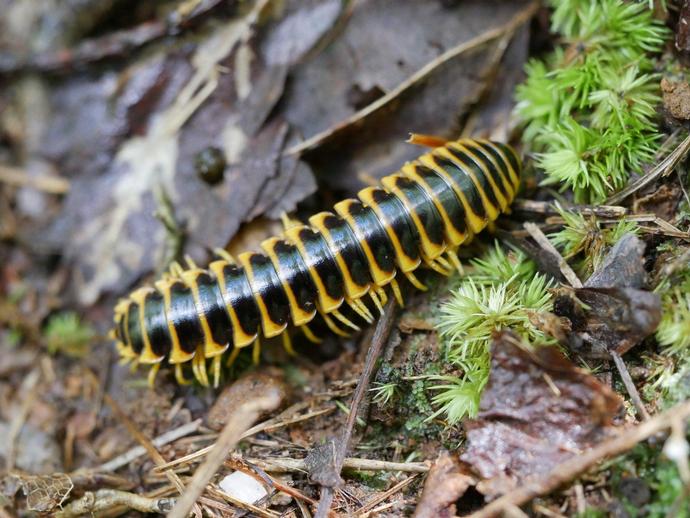March 8, 2021
Ben here with another edition of #BenInNature! Today's nature post is quite possibly the coolest one yet. It's a long story, but I promise it's an interesting one!
About a year ago, VMNH Myriapodologist (millipede expert) Dr. Jackson Means and Associate Curator of Invertebrate Zoology Dr. Kal Ivanov visited my family property in Patrick County for a millipede hunt. While we were out in the woods raking leaf litter, Dr. Means found this little guy. He had a suspicion that it was the Laurel Creek millipede Apheloria whiteheadi (and he was incredibly excited). Before he could confirm the ID, he had to examine the millipede's gonopods under a microscope (the gonopods are modified legs on a millipede's seventh body segment that function as reproductive organs, and their unique shapes are often the best way to identify a millipede). A look under the microscope (and some subsequent genetic testing) confirmed it: this was the Laurel Creek millipede!
Why was that such a big deal? This particular species of millipede was first discovered by the late, great VMNH Curator of Entomology Dr. Richard Hoffman. He had found it not too far from Mabry Mill on the Blue Ridge Parkway; as the story goes, Dr. Hoffman's fondness for the restaurant's buckwheat pancakes led directly to this discovery of this new species! And while many millipede enthusiasts (Dr. Means included) have hunted for a second population of these millipedes since Dr. Hoffman discovered them in the 1980s, it appeared that the entire species was localized to about one square kilometer near Mabry Mill ...
... that is, until they popped up in my own backyard, more than 20 kilometers from Mabry Mill as the crow flies, not to mention a 500 meter drop in elevation!
In all likelihood, these millipedes used to have a much larger distribution that has shrunk and fragmented over time. Realistically, there are probably other isolated pockets where these millipedes can be found in Patrick County, we just don't know about them. Since that first trip nearly a year ago, Dr. Means and Dr. Ivanov have found many more Apheloria whiteheadi in my woods, although all of them seem to be localized to one spot: a 50-foot stretch of an old logging road that's been abandoned since the 1940s.
What I hope these nature posts show is the amazing diversity of life that exists right under our noses. Since I started writing these nature posts nearly a year ago, Dr. Means and Dr. Ivanov have discovered a second population of one of Virginia's rarest millipedes in my woods; VMNH Research Associate Dr. Curt Harden has discovered not one, but two undescribed species of blind ground beetles; and I photographed a butterfly that had not officially been recorded in Patrick County since prior to the 1950s. There are some truly amazing critters out there; you just have to go look for them!
To read the recently published paper about the discovery of the second population of Apheloria whiteheadi and learn even more, please check out this link: https://virginianaturalhistorysociety.com/banisteria/pdf-files/ban55/Laurel_Creek_millipede_Means.pdf
ABOUT #BenInNature
Social distancing can be difficult, but it presents a great opportunity to become reacquainted with nature. In this series of posts, Administrator of Science Ben Williams ventures outdoors to record a snapshot of the unique sights that can be found in the natural world. New updates are posted Monday - Friday, with previous posts highlighted on the weekends. This series of posts is made possible thanks to the support of VMNH Corporate Partner Carter Bank & Trust (www.cbtcares.com).
NATURE PHOTO IDENTIFICATIONS
If you discover something in nature that you would like help identifying, be sure to message us right here on Facebook with a picture (please include location and date of picture) and we'll have our experts help you identify it!

 Hours & Admissions
Hours & Admissions Directions
Directions

